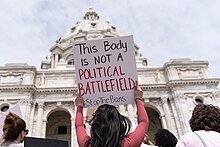In the months leading up to May 21st, 2019, several states in the United States passed highly restrictive abortion laws that served as a catalyst for widespread protests defending abortion rights. These legislative changes marked a significant shift in the legal landscape surrounding reproductive rights and sparked intense public debate. Notably, states such as Alabama, Georgia, Ohio, and Missouri introduced some of the most stringent anti-abortion measures seen in decades.
Alabama enacted a law that virtually banned all abortions, with no exceptions for cases of rape or incest, making it one of the most restrictive abortion laws in the nation. The law, signed by Governor Kay Ivey, criminalized the procedure for doctors, who could face up to 99 years in prison if convicted. Similarly, Georgia’s “heartbeat bill” prohibited abortions once a fetal heartbeat could be detected, typically around six weeks into pregnancy, a time when many women may not yet realize they are pregnant. Ohio and Missouri also passed similar “heartbeat bills,” further tightening the restrictions on abortion access.
These legislative moves were part of a broader strategy by anti-abortion advocates to challenge the 1973 Supreme Court decision in Roe v. Wade, which legalized abortion nationwide. By enacting these restrictive laws, proponents aimed to trigger legal battles that could potentially lead to a reconsideration of Roe v. Wade by the Supreme Court. The political motivations behind these laws were deeply rooted in the ongoing cultural and ideological divide over abortion in the United States.
Public opinion on abortion remains highly polarized. According to a 2019 Gallup poll, 49% of Americans identified as “pro-choice,” while 46% described themselves as “pro-life.” This division was mirrored in the legislative actions taken by state governments, often reflecting the prevailing views of their constituencies. Lawmakers supporting the restrictive measures argued they were protecting the rights of the unborn, while opponents contended that such laws infringed on women’s rights to make decisions about their own bodies.
The passage of these restrictive abortion laws in 2019 set the stage for the protests on May 21st, 2019. These demonstrations were a powerful response to what many perceived as an unprecedented attack on reproductive rights. The widespread public outcry highlighted the deep-rooted tensions and the critical importance of the ongoing debate surrounding abortion legislation in the United States.
The Protests: A Nationwide Movement for Abortion Rights
On May 21st, 2019, a wave of protests defending abortion rights surged across the United States, marking a significant moment in the ongoing battle for reproductive freedom. These protests took place in major cities such as New York, Los Angeles, Chicago, and Washington, D.C., drawing hundreds of thousands of participants. Organized by a coalition of advocacy groups, including Planned Parenthood, the American Civil Liberties Union (ACLU), and NARAL Pro-Choice America, the demonstrations aimed to counteract restrictive abortion laws being enacted in several states.
The scale of the protests was unprecedented, with estimates suggesting that over a million people participated nationwide. Eyewitness accounts and media reports highlighted the emotional fervor of the crowds, many of whom carried signs with slogans like “My Body, My Choice” and “Abortion is Healthcare.” The protests were further amplified by the extensive use of social media, where images and videos circulated widely, showcasing the intensity and passion of the demonstrators.
The immediate impact of the May 21st, 2019, protests was palpable. Politicians and policymakers took notice, with several states halting or reconsidering the implementation of restrictive abortion laws. The protests also spurred a broader national conversation about reproductive rights, galvanizing both grassroots and institutional support for the cause. In the months following the protests, there were notable legal challenges to anti-abortion legislation, some of which resulted in temporary injunctions or reversals.
In the long term, the protests of May 21st, 2019, reshaped the political and social landscape regarding abortion rights. The movement provided a renewed sense of solidarity and urgency among advocates, leading to increased voter mobilization and advocacy efforts. Public opinion polls conducted in the aftermath revealed a shift in attitudes, with a growing number of Americans expressing support for maintaining and protecting abortion rights. While the battle for reproductive freedom continues, the events of May 21st, 2019, remain a pivotal chapter in this ongoing struggle.
For further reading and to view firsthand accounts, images, and videos from the protests, you can visit external links such as news articles from The New York Times, social media posts on platforms like Twitter and Instagram, and interviews with key figures in the movement. These resources provide a comprehensive and immersive look into the historic protests that took place on that day.

